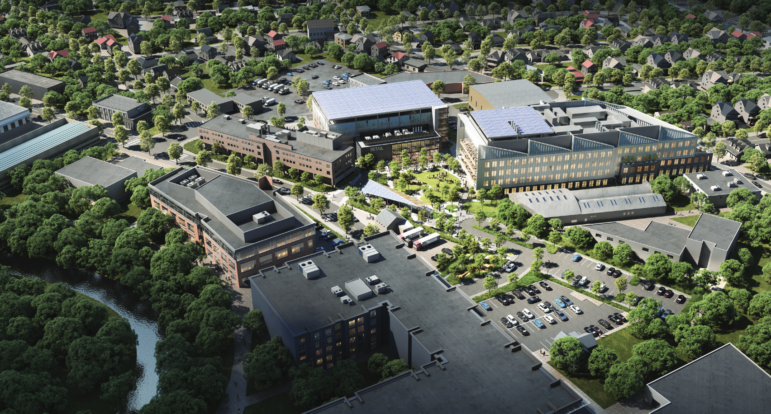
Developers heard from dozens of residents who showed up Monday night for an in-person community meeting about the project proposed for the former Cannistraro site, pro and against. Many with concerns lived in the residential neighborhood across the street, who fear they will be negatively impacted by the size of, and noise and traffic from the life science project.
The project includes parcels on Pleasant Street, Rosedale Road and Acton Street. The proposal calls for a four-story, 148,0000-sq.-ft. lab building with underground parking for 75 cars that would enter and exit from Acton Street, a five-story parking garage with 450 spaces, and a 10,000-sq.-ft. retail space attached to the garage. There will be a surface lot along Pleasant Street with parking for 42 vehicles. The project also includes the existing building at 313 Pleasant St., which will remain, as is.
At the March meeting, people spoke out about the size of the building and being so near a residential neighborhood, being located just across Acton Street from several homes. The same concerns were raised Monday by the attendees. Broder Managing Partner Eric Svenson said he and Broder’s other managing partner, Dana Nieslsen, are listening. They plan to own and manage the site after redeveloping it.
“People said it is too big, the massing is too big, there are concerns about development near a residential neighborhood,” Svenson said. “I have the same concerns.”
Svenson discussed the changes made to the project since the first community meeting in March, including cutting a story off the parking garage, adding underground parking beneath the life science building, and pushing back the upper floors of the life science building along Acton Street. He added that Broder does not seek to build to the maximum size allowed in the zoning for the are, which is Pleasant Street Corridor 3
A few people asked if the size of the project could be reduced. Svenson said that if the project was significantly scaled back they would not be able to make the project work. Broder purchased the property for $46.5 million from Cannistraro in 2021, according to an announcement by the broker, Colliers.
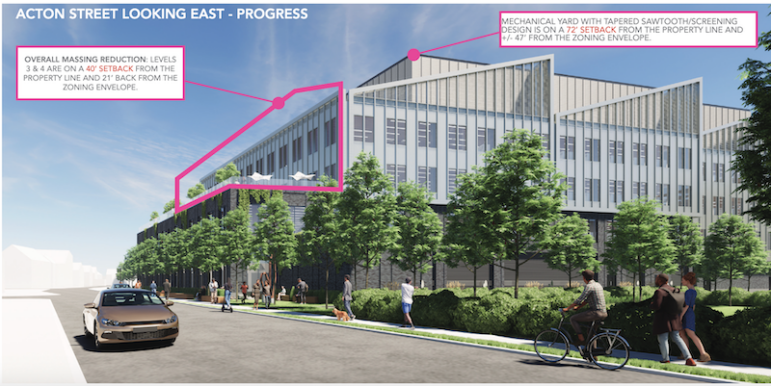
The current design has the third and fourth floor of the life science building pushed back 30 feet from the facade along Acton Street. The building starts over 10 feet from the property line along Acton Street. At its peak, at the top of the fencing around the roof mechanical equipment, the building will be 81 feet tall. The building’s full height will start 87 feet from the property line.
A nearby neighbor worried that the new building would cast a shadow on his home. Svenson said that while it is taller than the current building, even the 40-foot smokestack, the fact that it the tallest point is 87 feet from the property line means the shadow will not be nearly as significant as if the facade was that tall.
Some asked whether the building could be pushed back further off of Acton Street. Svenson said the options are limited by the water supply line for the City of Cambridge that runs through the property. The land is owned by Cambridge and no structure can be built on top of the water pipe. He added that he would see if the building could be pushed back another few feet off Acton Street.
The project includes a plaza in the middle, which Svenson said would be open to the public. The zoning allows for up to 50 feet setback from the property line for a public amenity, such as open space or a park. People suggested moving the area along the front of the building on Acton Street, but Svenson said Broder wants to create a campus with the open space in the middle.
The traffic flow also changed from the March plans where the access to the garage would all come off of Rosedale Road. The updated plan includes garage access from Rosedale and from Pleasant Street. Vehicles parking underneath the life science building would all enter from and exit onto Acton Street.
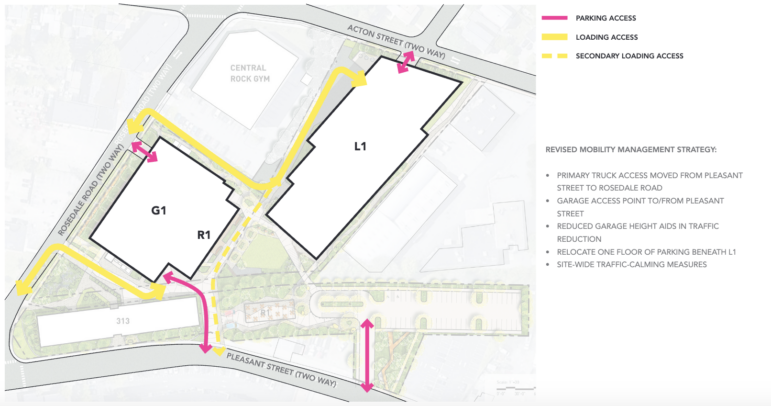
Some residents asked why any of the traffic was being directed onto Acton Street. Svenson said when a level of parking was removed from the garage it had to go somewhere. He added that that the site needs to have enough parking to make it marketable.
“We have to park enough cars or tenants won’t want to be here,” Svenson said. “We are in an area that is not on a bus line.”
Broder also wants to provide enough parking so that people do not have to park on the neighborhood streets. If there are open spaces on off-business hours, Svenson said that people in the neighborhood will be able to use the spots. He gave examples of snowy days or if someone is hosting an event at their home.
Svenson said Broder plans to install electric vehicle charging stations for each of the parking spaces in the garage. This is part of an effort to make the project sustainable. Broder seeks to build a LEED Platinum certifiable project, Svenson said, which is the highest level of sustainability.
The life science building has less glass than many projects to make the building lose less heat in the summer or reduce the amount of heat coming in during the summer. It will also be powered primarily by electricity. A natural gas generator will be needed as a backup to make sure that the equipment in the labs keep going during a power outage.
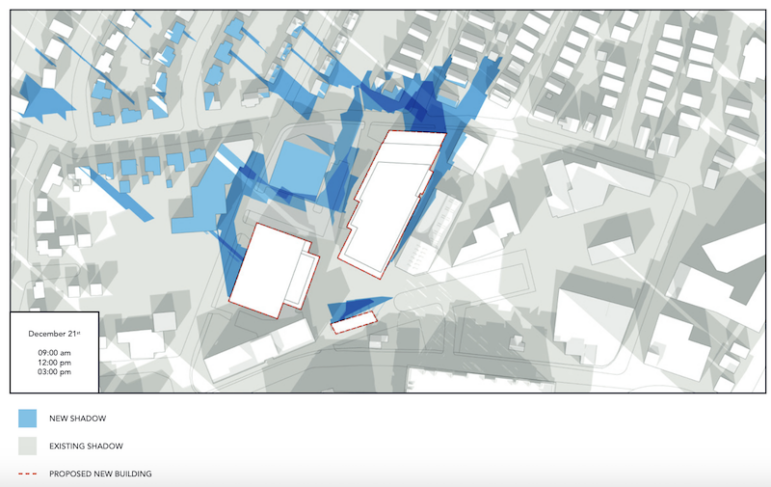
Monday’s meeting was held outside, and people noted the noise from the mechanical equipment on top of the building on Pleasant Street. Neighbors said they could hear it from their homes. They worried the new, larger building that is closer to the neighborhood would amplify the problem. Svenson said he is willing to build thicker, taller screening to dampen the noise as much as possible. Stephen Bradley, who manages the buildings for Broder, noted that the mechanics and screening on 313 Pleasant St. are retrofits, and the ones on the new building will be quieter.
Another worry was the emissions from the building, and possible accidents in the labs. Svenson said they will be the lowest two of the four levels of labs, BSL1 and 2, and that they must be inspected prior to opening and periodically afterward.
Residents had mixed reactions to Monday’s proposal.
Mary Anne Mulligan said that she was glad to see that Broder had made some changes in response to the concerns raised by residents, but she said the project site is an unusual one.
“This one impacts more homes — I can’t think of another project that impacts more homes,” Mulligan said. “Yes it is allowed (by Watertown’s zoning) but it is so densely packed near the homes.”
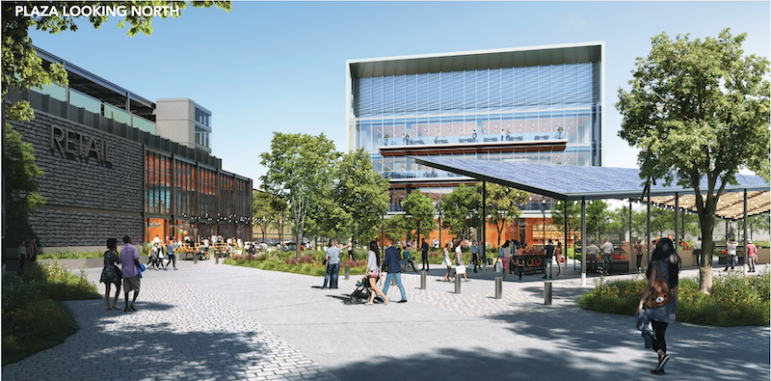
Others said they appreciated that Broder has been listening and is willing to work with people. Resident Maria Rose said she liked the design of the buildings, and said Broder should not be punished for the sins of other developers who previously worked in Watertown.
“They are listening to everybody, and Broder has to make a profit, otherwise we will have a vacant storefront,” Rose said.
The site sits right next to Central Rock Gym, and owner Joe Hardy said that his experience with Broder has been a very good one. Central Rock has 21 locations in five states, Hardy said, and he does not always have as good an experience with developers and property owners. Broder continued to allow the gym to use the parking lot after purchasing the property, and Hardy said Broder and Svenson have been responsive.
“He has been honest and a straight shooter from the start,” Hardy said. “If you have a problem, you have a number to call.”
Looks beautiful! Those lots need a facelift. Excited to see this built as soon as possible.
Excited to possibly have retail, dining and social options within walking distance for the folks of West Watertown. It’s a bit of a ghost town down this end.